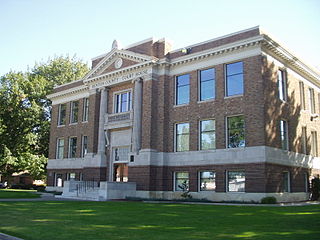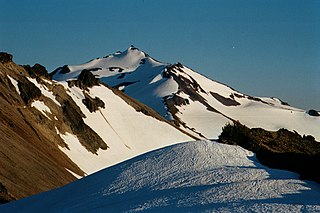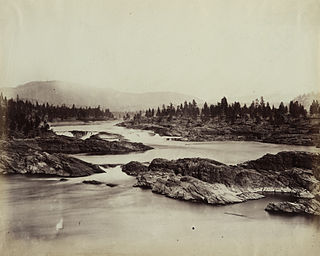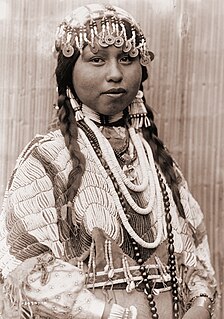
The Columbia River is the largest river in the Pacific Northwest region of North America. The river rises in the Rocky Mountains of British Columbia, Canada. It flows northwest and then south into the U.S. state of Washington, then turns west to form most of the border between Washington and the state of Oregon before emptying into the Pacific Ocean. The river is 1,243 miles (2,000 km) long, and its largest tributary is the Snake River. Its drainage basin is roughly the size of France and extends into seven US states and a Canadian province. The fourth-largest river in the United States by volume, the Columbia has the greatest flow of any North American river entering the Pacific. The Columbia has the 37th greatest discharge of any river in the world.

Richland is a city in Benton County, Washington, United States. It is located in southeastern Washington state at the confluence of the Yakima and the Columbia Rivers. As of the 2010 census, the city's population was 48,058, with a 2019 estimate from the Census Bureau putting its population at 58,225. Along with the nearby cities of Pasco and Kennewick, Richland is one of the Tri-Cities, and is home to the Hanford nuclear site.

Benton County is a county in the south-central portion of the U.S. state of Washington. As of the 2010 census, its population was 175,177. The county seat is Prosser, and its largest city is Kennewick. The Columbia River demarcates the county's north, south, and east boundaries.

The Yakama are a Native American tribe with nearly 10,851 members, based primarily in eastern Washington state.

Gifford Pinchot National Forest is a National Forest located in southern Washington, USA, managed by the United States Forest Service. With an area of 1.32 million acres (5300 km2), it extends 116 km along the western slopes of Cascade Range from Mount Rainier National Park to the Columbia River. The forest straddles the crest of the South Cascades of Washington State, spread out over broad, old growth forests, high mountain meadows, several glaciers, and numerous volcanic peaks. The forest's highest point is at 12,276 ft. at the top of Mount Adams, the second tallest volcano in the state after Rainier. Often found abbreviated GPNF on maps and in texts, it includes the 110,000-acre (450 km2) Mount St. Helens National Volcanic Monument, established by Congress in 1982.

White Bluffs was an agricultural town in Benton County, Washington, United States. It was depopulated in 1943 along with the town of Hanford to make room for the nuclear production facility known as the Hanford Site.

The Columbia River drainage basin is the drainage basin of the Columbia River in the Pacific Northwest region of North America. It covers 668,000 km2 or 258,000 sq mi. In common usage, the term often refers to a smaller area, generally the portion of the drainage basin that lies within eastern Washington.

Kettle Falls was an ancient and important salmon fishing site on the upper reaches of the Columbia River, in what is today the U.S. state of Washington, near the Canada–US border. The falls consisted of a series of rapids and cascades where the river passed through quartzite rocks deposited by prehistoric floods on a substrate of Columbia River basalt. The river dropped nearly 50 feet (15 m), and the sound of the falls could be heard for miles away. Kettle Falls was inundated in 1940, as the waters of the reservoir Lake Roosevelt rose behind Grand Coulee Dam, permanently flooding the site.

Celilo Falls was a tribal fishing area on the Columbia River, just east of the Cascade Mountains, on what is today the border between the U.S. states of Oregon and Washington. The name refers to a series of cascades and waterfalls on the river, as well as to the native settlements and trading villages that existed there in various configurations for 15,000 years. Celilo was the oldest continuously inhabited community on the North American continent until 1957, when the falls and nearby settlements were submerged by the construction of The Dalles Dam.

The Hanford Reach is a free-flowing section of the Columbia River, around 51 miles (82 km) long, in eastern Washington state. It is named after a large northward bend in the river's otherwise southbound course.

The Hanford Reach National Monument is a national monument in the U.S. state of Washington. It was created in 2000, mostly from the former security buffer surrounding the Hanford Nuclear Reservation. The area has been untouched by development or agriculture since 1943. Because of that it is considered an involuntary park.

The White Salmon River is a 44-mile (71 km) tributary of the Columbia River in the U.S. state of Washington. Originating on the slopes of Mount Adams, it flows into the Columbia Gorge near the community of Underwood. Parts of the river have been designated Wild and Scenic. The principal tributaries of the White Salmon River include Trout Lake and Buck, Mill, Dry, Gilmer, and Rattlesnake Creeks.

Wasco-Wishram are two closely related Chinook Indian tribes from the Columbia River in Oregon. Today the tribes are part of the Confederated Tribes of Warm Springs living in the Warm Springs Indian Reservation in Oregon and Confederated Tribes and Bands of the Yakama Nation living in the Yakama Indian Reservation in Washington.

Rattlesnake Mountain is a 3,531 ft windswept treeless ridge overlooking the Hanford nuclear site. Parts of the western slope are privately owned ranchland, while the eastern slope is under the federal protection of the Arid Lands Ecology Reserve, a unit of the Hanford Reach National Monument, managed by the United States Fish and Wildlife Service. The mountain is the second highest point in Benton County, with its neighbor Lookout Summit surpassing it by only 98 ft.

Savage Island lies on the last free flowing stretch of the Columbia River known as the Hanford Reach in Washington, United States; other interesting geological features of the area include the White Bluffs, as well across the river the Hanford Dunes. The island is within the boundaries of the Wahluke Wildlife Unit, a natural preserve managed by the Washington Department of Fish and Wildlife (WDFW). Historically, Savage Island has supported small farms and settlements ranging from prior to the Manhattan Project buyout of the lands in 1943; The Wanapum tribe were known to inhabit this particular region. The wildlife of the island include mule deer, coyote, burrowing owl, and western diamondback rattlesnake; the island is primarily arid shrub steppe, with some wetland habitat by the shore of the river.
Lavina Washines was the first female leader of the Yakama Nation, Washington, United States.

The Ringold Formation is a geologic formation in Eastern Washington, United States. The formation consists of sediment laid down by the Columbia River following the flood basalt eruptions of the Columbia River Basalt Group reaching up to 1,000 feet (300 m) thick in places. It preserves fossils dating back to the Neogene period.

The East Fork Lewis River is a river in the state of Washington in the United States. It is the largest tributary of the Lewis River. Its source is on Green Lookout Mountain in Skamania County. It then flows to the west through Clark County until it converges with the Lewis about 3.5 mi (5.6 km) upstream from the Columbia River.
The Columbia River Inter-Tribal Fish Commission (CRITFC) is a fishery resource for the treaty tribes of the Columbia River. Under the treaty, the native tribes, The Nez Perce Tribe, Warm Springs Reservation Tribe, and Umatilla Indian Reservation Tribe, have to the right to fish in the Columbia River, which means their fishery must be reserve and protect.

Pete Lake is a small alpine freshwater lake located on the southern stretch of the Alpine Lakes Wilderness in Kittitas County, Washington. Because of its proximity to the Pacific Crest Trail and Cle Elum Lake and Kachess Lake, Pete Lake is a popular area for hiking, camping, and fishing. Pete Lake is a short distance and along the trails that lead to Spectacle Lake at the base of Chikamin Peak and Cooper Lake to the South. Trails for backpacking are well-trafficked and originally designed in some areas for enough buffer that allows mountain biking.




















